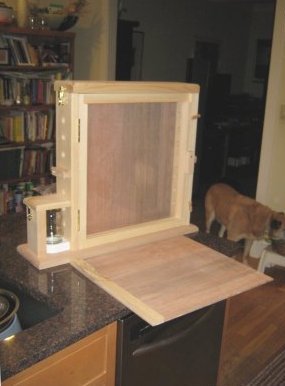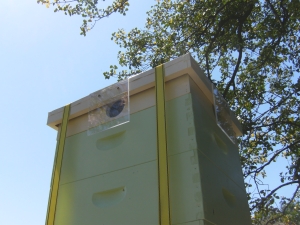 If there is one eternal truth in beekeeping, it's that committed beekeepers always get a bit nervous when someone else inspects their hive, especially if that someone else has kept bees even one week longer. I've got a few years on Charlie, bee-wise, but not that many. Even so, it makes my heart get all warm to see such concerns, because only people who really care have them. And the bees do so much better in the hands of those who care. Which is my way of saying that Charlie let me have a look at the White House honeybees today. Thanks, Charlie!
If there is one eternal truth in beekeeping, it's that committed beekeepers always get a bit nervous when someone else inspects their hive, especially if that someone else has kept bees even one week longer. I've got a few years on Charlie, bee-wise, but not that many. Even so, it makes my heart get all warm to see such concerns, because only people who really care have them. And the bees do so much better in the hands of those who care. Which is my way of saying that Charlie let me have a look at the White House honeybees today. Thanks, Charlie!
Before I go on, this needs to be said: everything touching on that particular place tends to get wrapped up in spotlights and drama, and there is a real danger of feeling self-important or personally special just because of that place and this time. When I share this with you, please keep in mind what this is really about: the bees, and their way of both supporting our environment and inspiring great wonder in those who look after them. I feel that we all owe Charlie a whole lot, and I want him and the Obamas (remember, it's their back yard right now!) and Sam Kass (whose garden project makes it all possible) to get their credit, too.
But I bet you want a look in, too.
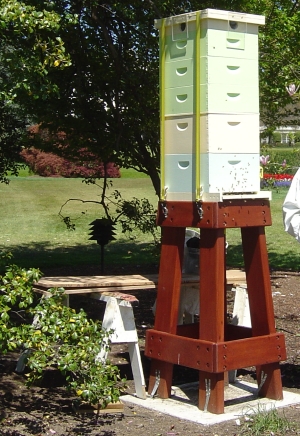 With apologies for the rough crop of the photo, this is how you work the White House bees: on a board set on two sawhorses. It helps to coordinate your movements and to balance anything you are up to with the other person up there! It is a surprisingly stable solution, with the plus that the bees that fall during a manipulation don't end up getting stomped, and you don't have to tuck in your socks to keep them from crawling up a pants leg! The groovy piece of woodenware (the one shielded by some plexiglass near the holes) is a vent of Charlie's own design. The plexi helps moderate high winds, whether natural or from helicopters. One unforeseen benefit of the hive scaffold: it is really easy to look up through the screened bottom board to see where/how tight the bees are clustering.
With apologies for the rough crop of the photo, this is how you work the White House bees: on a board set on two sawhorses. It helps to coordinate your movements and to balance anything you are up to with the other person up there! It is a surprisingly stable solution, with the plus that the bees that fall during a manipulation don't end up getting stomped, and you don't have to tuck in your socks to keep them from crawling up a pants leg! The groovy piece of woodenware (the one shielded by some plexiglass near the holes) is a vent of Charlie's own design. The plexi helps moderate high winds, whether natural or from helicopters. One unforeseen benefit of the hive scaffold: it is really easy to look up through the screened bottom board to see where/how tight the bees are clustering.
As you might imagine, a couple of key concerns for bees in this location are swarm control, and monitoring temperament. Our visit today was mostly around the former: to keep tabs on how they are building up and reverse the hive bodies if that seemed useful, and to make sure there were enough supers in place for the current and soon-to-be-upcoming nectar flow.
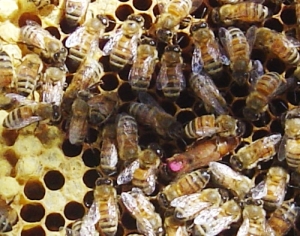 To my mind, Charlie's queen is a good one for the job. The bees were extremely peaceful and gentle, and her pattern was OK, though not gangbusters. In a situation like this, I am all for the happy medium in terms of brood production! The drone brood was in the right place, she seemed to lay more from right to left than in a spiral starting in the center of the frame. You can click that picture of her for a slightly larger version.
To my mind, Charlie's queen is a good one for the job. The bees were extremely peaceful and gentle, and her pattern was OK, though not gangbusters. In a situation like this, I am all for the happy medium in terms of brood production! The drone brood was in the right place, she seemed to lay more from right to left than in a spiral starting in the center of the frame. You can click that picture of her for a slightly larger version.
When we opened some drone brood, there was a minimal presence of varroa. There were no k-wings and I saw no mites on bees. The hive has three medium supers with drawn comb, there is a fair amount of nectar in the first two, so Charlie is out ahead of this one. They had put aside some honey down below, but I am seeing that at home, too. Nice white cappings.
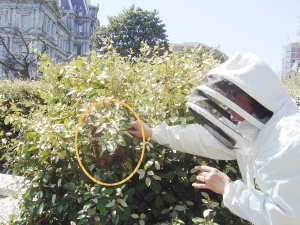 Finally, as I was saying goodbye, Charlie got a call aboutanother swarm at the north gate! I said I would take it if accessible. So we checked it out. It was clearly a second swarm, probably thrown off of the same nearby hive that produced the famous one last week: about 2 pounds (1 kg) of bees (image is clickable for a better view). Since I am giving away a split this weekend, I thought my friend might want this queen to go with it!
Finally, as I was saying goodbye, Charlie got a call aboutanother swarm at the north gate! I said I would take it if accessible. So we checked it out. It was clearly a second swarm, probably thrown off of the same nearby hive that produced the famous one last week: about 2 pounds (1 kg) of bees (image is clickable for a better view). Since I am giving away a split this weekend, I thought my friend might want this queen to go with it!
Charlie got me a box, poked some holes in it with a nail, and we borrowed some bolt cutters from the carpentry shop to lop a small limb off the swarm bush. Sorry bush! He sealed the box shut with blue gaffer's tape, and in a supporting page (a bit later) I will tell you about my hapless adventures in hiving it when I got home.
So once again, thank you for including me in this adventure, for doing such a wonderful thing, and for taking care of those girls the way any one of us would hope our own home hives get tended. I hope you get as much help as you could possibly need in helping them thrive so close to the heart of our nation!
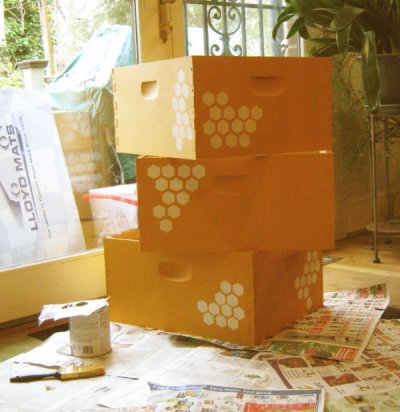 This is the second of two cold, rainy days in a row, and I must finally be catching up because this poor blog is getting some attention. You can see, in this picture, what Spring can bring when the only ways of working for the bees involve paint brushes, newspaper, and a fair amount of cursing.
This is the second of two cold, rainy days in a row, and I must finally be catching up because this poor blog is getting some attention. You can see, in this picture, what Spring can bring when the only ways of working for the bees involve paint brushes, newspaper, and a fair amount of cursing.